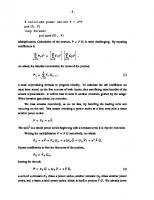Squinting at power series
Data streams are an ideal vehicle for handling power series. Stream implementations can be read off directly from simple
310 67 60KB
English Pages 28
Recommend Papers
File loading please wait...
Citation preview
Squinting at Power Series M. Douglas McIlroy AT&T Bell Laboratories Murray Hill, New Jersey 07974 ABSTRACT Data streams are an ideal vehicle for handling power series. Stream implementations can be read off directly from simple recursive equations that define operations such as multiplication, substitution, exponentiation, and reversion of series. The bookkeeping that bedevils these algorithms when they are expressed in traditional languages is completely hidden when they are expressed in stream terms. Communicating processes are the key to the simplicity of the algorithms. Working versions are presented in newsqueak, the language of Pike’s ‘‘squint’’ system; their effectiveness depends critically on the stream protocol. Series and streams Power series are natural objects for stream processing. Pertinent computations are neatly describable by recursive equations. CSP (communicating sequential process) languages 1, 2 are good vehicles for implementation. This paper develops the algorithmic ideas and reduces them to practice in a working CSP language, 3 not coincidentally illustrating the utility of concurrent programming notions in untangling the logic of some intricate computations on sequences. This elegant approach to power series computation, first demonstrated but never published by Kahn and MacQueen as an application of their data stream system, is still little known. 4 Power series are represented as streams of coefficients, the exponents being given implicitly by ordinal position. (This is an infinite analogue of the familiar representation of a polynomial as an array of coefficients.) Thus the power series for the exponential function ex =
∞
x n / n! Σ n =0
1 1 1 = 1 + x + __ x 2 + __ x 3 + ___ x 4 + . . . 24 6 2
-2is represented as a stream of rationals: 1 1 1 1 , 1 , __ , __ , ___ , . . . 2 6 24 Throughout the paper power series will be denoted by symbols such as F, with the functional form F(x) being used when the variable must be made explicit. Subscripts denote individual coefficients: F(x) =
∞
Fi xi . Σ i =0
The corresponding stream will be referred to by the same symbol in program font: F. In programs the names of power series variables contain capital letters; scalars are all lower case. When new power series are calculated from old, the input series will always be called F and G. In this section all programs are written in pseudocode; later they will be translated into the language ‘‘newsqueak’’ to be run in the ‘‘squint’’ system.* The methods are strictly formal; analytic interpretation of results depends on the convergence of the power series in question. Thus assertions such as Σ i x i = 1/( 1 − x) are understood to hold only where the series converge. Addition. The sum, S = F + G, is easy. Since S i = F i + G i , all we need is a looping process, which gets pairs of coefficients from the two inputs and puts their sum on the output S. The following pseudocode suffices. # calculate power series S = F + G loop forever let f = get(F), g = get(G) put(f+g, S) Multiplication by a term. Simple termwise operations on single power series, such as multiplication by a constant, integration, or differentiation are equally easy to program and are left to the reader’s imagination. Multiplication of a power series by x to yield P = x F involves a one-element delay: * The name of the language reveals descent from a mousier ancestor intended for programming a terminal with multiple asynchronous windows. The name ‘‘squint’’ suggests ‘‘squeak interpreter.’’
-3# calculate power series P = x*F put(0, P) loop forever put(get(F), P) Multiplication. Calculation of the product, P = F G, is more challenging. By equating coefficients in ∞ ∞ n i j G x P x = F x , j n i Σ Σ Σ n =0 i = 0 j = 0 ∞
we obtain the familiar convolution for terms of the product, Pn =
n
Σ Fi Gn −i , i =0
(1)
a most unpromising formula to program directly. To calculate the nth coefficient we must have stored up the first n terms of both inputs, thus sacrificing most benefits of the stream representation. It will be best to look in another direction, guided by the adage: When iteration gets sticky, try recursion. We treat streams recursively, as we do lists, by handling the leading term and recurring on the tail. This means rewriting a power series as a first term plus x times another power series: _ F = F 0 + x F. _ The tail F is a whole power series beginning with a constant term; it is ripe for recursion. Writing the multiplication P = F G recursively, we obtain _ __ _ _ __ P 0 + x P = F 0 G 0 + x (F 0 G + G 0 F ) + x 2 F G . Equate coefficients to find the first term of the product, P0 = F0 G0 , leaving for the tail, _ __ _ _ __ P = F 0 G + G 0 F + x F G,
(2)
a sum of a constant F 0 times a power series, another constant G 0 times another power _ __ series, and x times a third power series, which is itself a product F G. We already know
-4how to multiply power series by a constant and how to add power series. We also know how to multiply power series by x; recursion does the rest. In the following pseudocode, f*G denotes an auxiliary stream for the product f G, and so on. Each auxiliary stream will be computed by another process. Thus f G will be computed by a process that multiplies a power series by a constant. When two auxiliary streams share an input stream, both see every element of the input. # calculate power series P = F*G let f = get(F),
__ # F and G now "contain" Fbar and G # F0 G0
g = get(G) put(f*g, P)
let fG = f*G, gF = g*F, xFG = x*(F*G) # here is the recursion loop forever put(get(fG) + get(gF) + get(xFG), P) The convolution (1) has been hidden completely; all the necessary bookkeeping and storage management is embodied in the topology and contents of the auxiliary streams. Streams fan out to feed multiple consumers. For instance G enters into both f*G and F*G. The topology ramifies as the recursion progresses; more auxiliary streams appear at every stage, making the recursive picture of Figure 1. To write the program, though, we need not think about the topology, for the program is a direct image of the mathematics (2), and the mathematics is simple. Substitution. Substitution, or composition, of power series, defined by S = F(G), may be done similarly, using multiplication as a subprocess. The recursive formulation is _ __ _ __ S 0 + x S = F 0 + (G 0 + x G ) F (G 0 + x G ). Equate coefficients to find the constant term, _ S 0 = F 0 + G 0 . ( first term of F (G) ). Induction shows that in general S 0 is an infinite sum. S0 =
∞
Σ F i G0 . i =0 i
To keep the problem finite, we further stipulate that G 0 = 0. Now
-5-
F
G
×G 0
×F 0 _ __ F ×G ×x
+
F×G
Figure 1. Data flow for multiplication. The outer box represents the process for the tail of F G, equation (2). The similar inner box does not receive the first terms of F or G, and its output does not enter into the first two terms of the product F G. The newsqueak implementation uses a separate process for each box, and one or more processes for each stream splitting. Viewed as a three-dimensional scene receding into the distance, the picture shows a simple repeating structure connected on top by F and G buses. The buses grow, extending one level further with the receipt of each input term. A daisy chain of output connections leads from back to front. _ __ _ S = S 0 + x S = F 0 + x G F (G) , from which pseudocode can be read off.
(3)
-6# calculate power series S = F(G) put(get(F), S) # F0 let FG = F(G) let g = get(G) let GF = G*FG loop forever put(get(GF), S)
_ # the recursion, F (G) # discard the first term (must be 0) __ _ # G F (G)
A subtlety: the G in let FG = F(G) stands for the whole power series, while the G in __ let GF = G*FG stands only for the tail G. In the same way, the meaning of F changes between get(F) and let FG = F(G). Exponentiation. We wish to compute X = e F . From the recursive representation, _ xF
X = e
F0
e
X = e
F0
. ( 1 + terms in x).
,
(4)
we see that
To make the constant term of X rational, we further require that F 0 = 0. Hence X 0 = 1. Unfortunately equation (4) does not lead to an algorithm. Formal substitution yields _ X(x) = 1 . X(x X ).
(5)
_ Since the first term of X(x) depends on the first term of X(x X ), we are stuck in an infinite regress. By induction we may conclude that the first term is an infinite product of ones, but what are the higher terms? We can ‘‘cheat,’’ and substitute F in the known power series for the exponential. It is more satisfying, though, to build from nothing and let the program ‘‘discover’’ the exponential for itself. A neat trick suffices. The identity, d X ′ = ___ e F = e F F ′ = X F ′ , dx may be read as a differential equation for X, with the formal solution, x
X(x) =
∫ X(t) 0
F ′ (t) dt + c,
-7where the constant of integration c is the constant term X 0 = 1. Now we can sketch the program. # calculate X = exp(F), where F 0 = 0 let D = deriv(F), P = X*D, I = integ(P, 1) loop forever put(get(I), X) Here the stream operator deriv differentiates and the operator integ integrates with a given constant of integration. The calculation involves a data stream loop: X enters as an input into the calculation of X. Unlike the recursion in equation (5), this self-reference is benign. Deadlock is avoided because the integral operator produces the first term of its output (the constant of integration) before it needs any input. This result gets fed onto stream X to help calculate the next term, and so on. The method of calculating power series by integration feeding on itself has a distinguished lineage. It may be recognized as an instance of the classical Picard method of successive approximations for solving y ′ = f (x,y). 5 It was first used in stream context by Kahn and MacQueen. Abelson and Sussman give the degenerate case of exp (x). 6 Evidently the network of streams for calculating a product or an exponential entails careful scheduling. Certain lazy-evaluation systems, such as Miranda, handle such scheduling invisibly. 7 For example, in terms of lazily-evaluated infinite lists, we may write the following functional pseudocode for power-series addition and multiplication. let add(F, G) = cons(head(F)*head(G), add(tail(F), tail(G))) let cmul(c, F) = cons(c*head(F), cmul(c, tail(F))) let mul(F,G) = let f = head(F), g = head(G), Fbar = tail(F), Gbar = tail(G) in cons(f*g, add(cmul(f, Gbar), add(cmul(g, Fbar), cons(0, mul(Fbar, Gbar)))))
-8These functions follow from the same recursive equations as did the previous pseudocode, with head and cons playing the role of get and put. Lazily-evaluated languages are, alas, not widely disseminated. Moreover, they do not inherently offer control over the exploitation of parallelism. An alternative exists in CSP languages. These languages require some infrastructure to be built to handle the scheduling. Once that is done, it becomes possible to write more efficient (though more verbose) code in CSP style. We shall return to this comparison at the end of the paper. In the meantime we proceed to an implementation in a channel-based CSP language.
Translation to newsqueak Pike’s newsqueak language supports asynchronous processes communicating over typed channels. Channels and functions are first-class citizens. Values of both kinds may be assigned to variables, passed as arguments, and returned by functions. Processes and channels may be created at will. There is just one kind of interprocess communication—rendezvous of two processes on a channel. Consequently the queuing and fanout that are necessary for power series computations must be programmed explicitly. A fair choice is made among competing rendezvous. When not waiting for rendezvous, all processes progress, at dithered rates, a few atomic operations per interpreter cycle. Most of newsqueak will be familiar to experienced programmers. The communication semantics descends mainly from CSP, 1 the syntax from C, and the type system from Pascal and ML. 8 Unusual features will be described as they are needed. For details see the accompanying paper and the manual. 3, 9 At base we need rationals, declared as numerator-denominator pairs, and power series, declared as channels that carry rationals, # rationals and power series - basic declarations type rat: struct of { num: int; den: int; }; type ps: chan of rat; along with some obvious support routines, declared as follows. The literal definitions of these functions, all one-liners, have been left out, simply to avoid discussing the finicky, but straightforward, matter of data constructors.
-9ratmk: prog(i:int, j:int) of rat; ratadd: prog(r:rat, s:rat) of rat; ratsub: prog(r:rat, s:rat) of rat; ratmul: prog(r:rat, s:rat) of rat; ratprint: prog(r:rat);
# # # # #
construct a rational i/j return sum of rationals subtract multiply print a rational
psmk: prog() of ps;
# construct a power series
A program to print (endlessly) a power series is easy. To write it, though, we need some peculiar newsqueak syntax. Beware, in newsqueak := is not a simple assignment. It declares and initializes a new variable of a type inferred from the initializing expression. Assignment is represented by = as in C. The prefix operator
![Biochemistry - Board Review Series [index at end]](https://ebin.pub/img/200x200/biochemistry-board-review-series-index-at-end.jpg)








